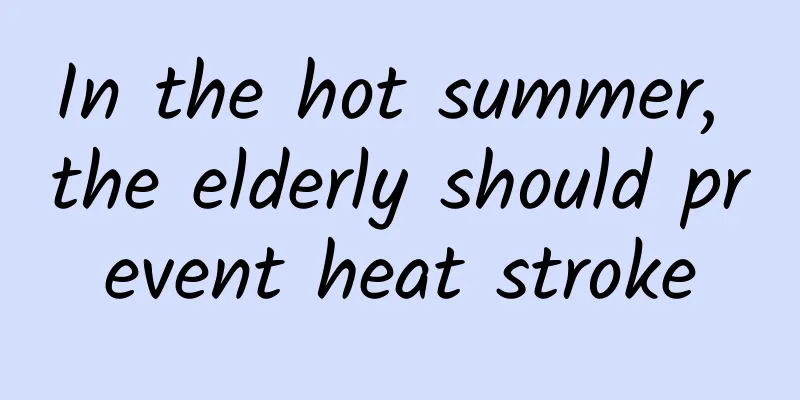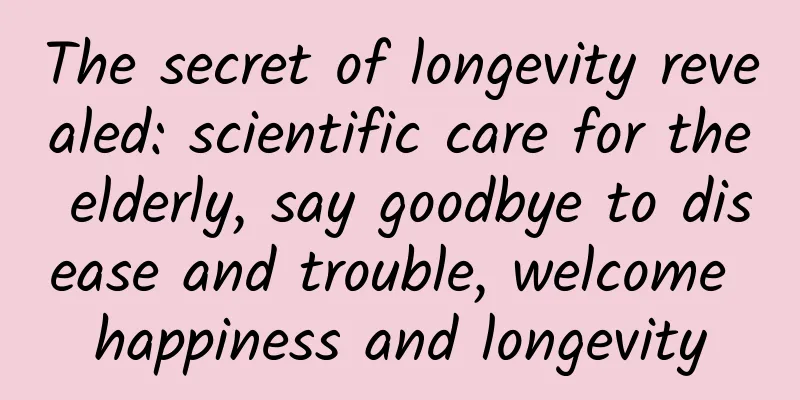In the hot summer, the elderly should prevent heat stroke

|
This is the 3221st article of Da Yi Xiao Hu "Summer is full of grains and summer heat is connected in the middle". The Lesser Heat and Greater Heat following the Summer Solstice are the hottest seasons of the year. The weather is hot and humid, and coupled with some physiological characteristics of the elderly, it is easy to get heatstroke. Heatstroke in the elderly is often severe, with many complications, and the prognosis is worse than that of young people. In severe cases, it is even life-threatening. Our elderly friends can avoid heatstroke in the unbearable and scorching summer by understanding some of the characteristics and prevention and treatment measures of heatstroke, and enjoy the beauty of summer with birds singing and cicadas chirping and lush trees. Why are the elderly more susceptible to heat stroke? Heatstroke is a disease characterized by dysfunction of the body temperature regulation center, failure of sweat gland function, and excessive loss of water and electrolytes in hot weather, high humidity, and windless environment. Early symptoms of heatstroke may include sweating, headache, dizziness, fever, pale face, fatigue, nausea, etc. The elderly have poor perception, especially those with sequelae of stroke, Alzheimer's disease, and mental disorders are not sensitive to high temperature invasion. Before the elderly show these symptoms, they may have suffered from heatstroke and collapse; secondly, the elderly sweat glands have reduced heat dissipation capacity, and the body heat is not easy to dissipate, or the elderly who are taking diuretics lose more water in their bodies; some elderly people do not like to turn on the air conditioner in a hot and humid environment for various reasons, which are all reasons for heatstroke. Classification and manifestations of severe heat stroke Severe heat stroke is usually divided into heat cramps, heat exhaustion and heat (sun) stroke. Although the pathogenesis and clinical manifestations of the above three clinical types are different, two or three types can coexist clinically and cannot be clearly distinguished. Some people divide heat stroke into "exertional heat stroke" and "non-exertional heat stroke", which are also called "exertional heat stroke and typical heat stroke" abroad. Exertional heat stroke is more common in healthy young people. It occurs a few hours after engaging in heavy physical labor or strenuous exercise. Patients sweat a lot, have a significantly faster heart rate, and an increased pulse pressure. They may develop rhabdomyolysis, liver and kidney failure, disseminated intravascular coagulation, and multiple organ dysfunction. Non-exertional heat stroke is more common in elderly and frail urban residents living in crowded and poorly ventilated areas. Symptoms include dry, hot, red, and sweatless skin, with rectal temperatures reaching over 40°C. Symptoms include abnormal behavior or epileptic seizures, followed by delirium, coma, and symmetrical pupil constriction. If treatment is not timely, severe patients may experience coma, cerebral edema, gastrointestinal bleeding, abnormal coagulation function, and low platelets. Studies have shown that the platelet count of patients with severe heat stroke is significantly reduced in the acute phase, which is positively correlated with the severity of the heat stroke. The more severe the condition, the lower the platelet count. First aid measures for heat stroke If you experience fever, dizziness, headache, muscle cramps, dry skin, nausea, etc. when working or living in a high temperature, high humidity, and poorly ventilated environment, you may consider heatstroke after excluding other diseases. The primary goal of treatment is rapid cooling. Pre-hospital cooling 1. Help the patient lie down in a cool place or a space with air conditioning or a fan. 2. Replenish water and electrolytes by taking cold salt water or cool salty drinks orally. 3. Use wet towels, ice bags, ice cubes, and fans to cool down. Ice bags or ice cubes can be wrapped in a thin towel and placed on both sides of the patient's neck, thighs, or armpits. These areas are rich in blood vessels and have a good cooling effect. 4. If the condition is serious, send the patient to the hospital. In-hospital treatment 1. Physical cooling: Apply ice packs to the head and exposed parts of the body's large blood vessels; wipe the skin of the limbs with 4°C cold water and alcohol; use a cooling blanket. 2. Central cooling of the body: For non-diabetic patients with severe conditions, 1000ml of 4-10℃ 5% glucose saline can be infused centripetally through the femoral vein; 1000ml of 4-10℃ 10% glucose saline can be used for enema; 1000ml of 4-10℃ 10% glucose saline can be used for nasogastric feeding. 3. Drug cooling: Combinations of dexamethasone, chlorpromazine, promethazine, pethidine, etc., such as Hibernation I, which is suitable for patients with high fever, coma and convulsions; Hibernation II, which is suitable for patients with high fever and coma without convulsions; Hibernation III, which is suitable for patients with high fever but not coma or convulsions. 4. Keep the airway open and give oxygen; correct water, electrolyte disorders and acid-base balance. 5. Treatment of complications: Cerebral edema can be treated with mannitol for dehydration; acute renal failure can be treated with dialysis. First aid tips 1. The elderly, patients with chronic diseases, the weak, and the mentally ill are prone to heatstroke. 2. The mortality rate is proportional to the duration of fever, so early diagnosis and treatment must be emphasized. 3. The cooling goal should be to reduce the rectal temperature to 37.8℃~38.9℃ within 1 hour. 4. When the rectal temperature reaches 38°C, do not continue to cool down, but closely observe changes in body temperature. 5. Shock, pulmonary edema, disseminated intravascular coagulation (DIC), and multiple organ dysfunction syndrome (MODS) are early causes of death from heat stroke. Acute renal failure and secondary infection are often late causes of death. There is a risk of peripheral nerve demyelinating lesions in about a week. 6. Patients with severe heatstroke should pay attention to thrombocytopenia in the early stage, which can be corrected by transfusing platelets, frozen plasma, and coagulation factors. After a few days, platelet count may increase and a hypercoagulable state may occur, which can prevent complications such as thrombosis, pulmonary embolism, myocardial infarction, and cerebral infarction. Prevention of heat stroke 1. In dietary conditioning, multi-dimensional and light foods should be the main focus. You can eat more vitamin-rich and cooling foods such as bitter melon, tomatoes, cucumbers, lettuce, lotus seeds, etc. 2. Drink plenty of water, in small amounts and multiple times, and don’t wait until you are thirsty to drink water; wear loose and absorbent clothes, such as cotton clothes. 3. To prevent indoor heat stroke, indoor ventilation should be maintained. If natural wind cannot achieve the cooling and dehumidification effect, auxiliary facilities such as air conditioning should be used when necessary to ensure that the room temperature is between 26℃ and 28℃. The elderly should get rid of their fear of air conditioning. For some disabled or mentally ill elderly people, their families should pay more attention to their living environment and keep it clean, ventilated and at a suitable temperature. 4. To prevent outdoor heatstroke, it is recommended that the elderly avoid going out during the hottest afternoon and afternoon hours, and try to conduct outdoor activities in the shade. It is best for the elderly to be accompanied by family members when going out, and to prepare sun protection equipment and some emergency heatstroke prevention medicines in case of emergencies. 5. Open the windows frequently to keep the indoor air circulating and ensure adequate rest and sleep. It is best to have a 1-2 hour nap at noon every day. It is best for the elderly at home to have someone accompany them. 6. Maintain a good mood, be emotionally stable, avoid being impatient, angry, and reduce fatigue. Author: Shanghai Fifth People's Hospital Affiliated to Fudan University Zhang Xuemin, Chief Physician, Department of Geriatrics |
<<: Sports Injury Prevention in Badminton
>>: What are the benefits of eating mulberries? Why do mulberries lose color?
Recommend
Continuous red alerts are coming! It has become the first choice for those who "buy, replace and burn" and is also a must-have for Shanghai people in summer!
Author: Fluent These days Shanghai is shrouded in...
Mycoplasma pneumonia, why are there so many cases suddenly?
Recently, many places in China are experiencing a...
Blood in the nose during pregnancy
During pregnancy, if a pregnant woman gets angry,...
Is it still possible to have children after menopause?
When women reach a certain age, such as around 50...
What should I pay attention to when drinking cola and coffee together? What should I pay attention to when drinking tea and coffee together?
Coffee (English: coffee) is a beverage made from ...
How to dress for slightly fat women
Although every woman wants to be thinner, some wo...
What is the self-test method for female sexual frigidity?
Making love is a matter between two people. If on...
I took the contraceptive pill and my period came half a month earlier
In life, some women take birth control pills for ...
Does spontaneous abortion require uterine curettage?
The so-called uterine curettage in medicine refer...
What are the remedies for contraceptive failure?
Nowadays, many women do not want to have more chi...
Why does the gestational sac come out on its own?
I believe that many pregnant women do not know th...
What are the symptoms of simple vaginitis?
Gynecological diseases are a major concern for ma...
[Medical Q&A] What is a pain pump and will using it lead to dependence?
Planner: Chinese Medical Association Reviewer: Lu...
What to eat to help soften the cervix and how to do it
The problem of hardened cervix is a very distre...
How to identify the gender of a pregnant woman by the color of her urine
In fact, every pregnant woman is curious about th...









